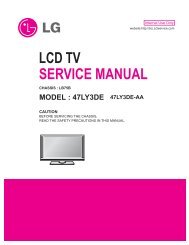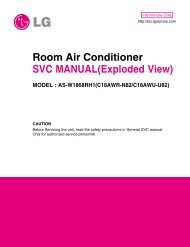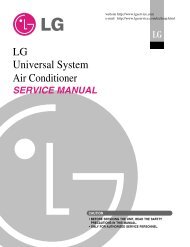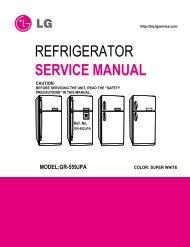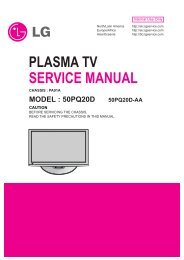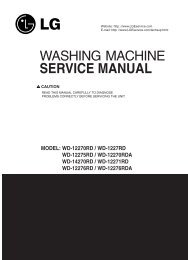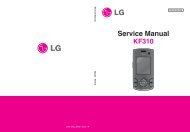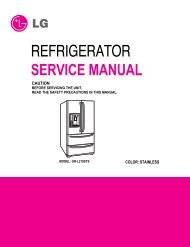LED LCD TV SERVICE MANUAL - Jordans Manuals
LED LCD TV SERVICE MANUAL - Jordans Manuals
LED LCD TV SERVICE MANUAL - Jordans Manuals
Create successful ePaper yourself
Turn your PDF publications into a flip-book with our unique Google optimized e-Paper software.
Copyright © 2010 LG Electronics. Inc. All rights reserved.<br />
Only for training and service purposes<br />
SAFETY PRECAUTIONS<br />
Many electrical and mechanical parts in this chassis have special safety-related characteristics. These parts are identified by in the<br />
Schematic Diagram and Exploded View.<br />
It is essential that these special safety parts should be replaced with the same components as recommended in this manual to prevent<br />
Shock, Fire, or other Hazards.<br />
Do not modify the original design without permission of manufacturer.<br />
General Guidance<br />
An isolation Transformer should always be used during the<br />
servicing of a receiver whose chassis is not isolated from the AC<br />
power line. Use a transformer of adequate power rating as this<br />
protects the technician from accidents resulting in personal injury<br />
from electrical shocks.<br />
It will also protect the receiver and it's components from being<br />
damaged by accidental shorts of the circuitry that may be<br />
inadvertently introduced during the service operation.<br />
If any fuse (or Fusible Resistor) in this <strong>TV</strong> receiver is blown,<br />
replace it with the specified.<br />
When replacing a high wattage resistor (Oxide Metal Film Resistor,<br />
over 1 W), keep the resistor 10 mm away from PCB.<br />
Keep wires away from high voltage or high temperature parts.<br />
Before returning the receiver to the customer,<br />
always perform an AC leakage current check on the exposed<br />
metallic parts of the cabinet, such as antennas, terminals, etc., to<br />
be sure the set is safe to operate without damage of electrical<br />
shock.<br />
Leakage Current Cold Check(Antenna Cold Check)<br />
With the instrument AC plug removed from AC source, connect an<br />
electrical jumper across the two AC plug prongs. Place the AC<br />
switch in the on position, connect one lead of ohm-meter to the AC<br />
plug prongs tied together and touch other ohm-meter lead in turn to<br />
each exposed metallic parts such as antenna terminals, phone<br />
jacks, etc.<br />
If the exposed metallic part has a return path to the chassis, the<br />
measured resistance should be between 1 MΩ and 5.2 MΩ.<br />
When the exposed metal has no return path to the chassis the<br />
reading must be infinite.<br />
An other abnormality exists that must be corrected before the<br />
receiver is returned to the customer.<br />
IMPORTANT SAFETY NOTICE<br />
- 3 -<br />
Leakage Current Hot Check (See below Figure)<br />
Plug the AC cord directly into the AC outlet.<br />
Do not use a line Isolation Transformer during this check.<br />
Connect 1.5 K / 10 watt resistor in parallel with a 0.15 uF capacitor<br />
between a known good earth ground (Water Pipe, Conduit, etc.)<br />
and the exposed metallic parts.<br />
Measure the AC voltage across the resistor using AC voltmeter<br />
with 1000 ohms/volt or more sensitivity.<br />
Reverse plug the AC cord into the AC outlet and repeat AC voltage<br />
measurements for each exposed metallic part. Any voltage<br />
measured must not exceed 0.75 volt RMS which is corresponds to<br />
0.5 mA.<br />
In case any measurement is out of the limits specified, there is<br />
possibility of shock hazard and the set must be checked and<br />
repaired before it is returned to the customer.<br />
Leakage Current Hot Check circuit<br />
To Instrument’s<br />
exposed<br />
METALLIC PARTS<br />
AC Volt-meter<br />
0.15 uF<br />
1.5 Kohm/10W<br />
Good Earth Ground<br />
such as WATER PIPE,<br />
CONDUIT etc.<br />
When 25A is impressed between Earth and 2nd Ground<br />
for 1 second, Resistance must be less than 0.1 Ω<br />
*Base on Adjustment standard<br />
LGE Internal Use Only



